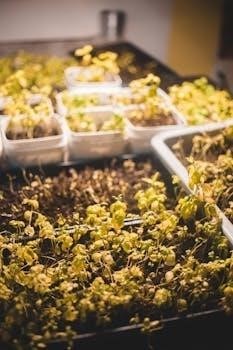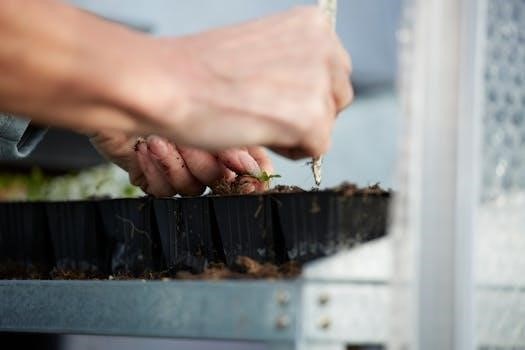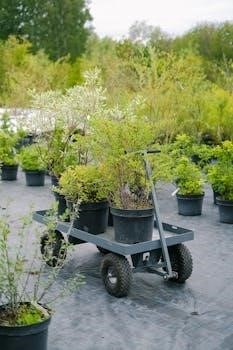Jiffy Seed Starting Greenhouse Kit⁚ Overview
The Jiffy Seed Starting Greenhouse Kit is designed for both beginner and experienced gardeners. It offers a self-contained system that simplifies starting seeds indoors. The kit includes peat pellets, a tray, and a humidity dome, creating an ideal environment for germination and growth.
Kit Components and Features
The Jiffy Seed Starting Greenhouse Kit typically includes several key components designed to facilitate successful seed germination and early plant growth. The core of the kit is the Jiffy-7 peat pellets, which are compressed peat moss encased in a thin netting. These pellets expand significantly when hydrated, providing a suitable growing medium for seeds. A durable plastic base tray is included to hold the peat pellets, ensuring stability and preventing water leakage. A clear plastic dome is also provided to create a greenhouse effect, maintaining humidity and warmth crucial for seed germination. The kit may also include plant labels for easy identification of different seedlings and sometimes a bonus packet of SUPERthrive, a plant vitamin to promote healthy growth. Some kits may come with varying quantities of peat pellets, such as 36, 72, or 16 larger pellets, catering to different gardening needs. The clear dome features a special edge that allows condensation to drip back inside, maintaining optimal moisture levels. The components are designed to be easy to use, making the kit accessible for gardeners of all skill levels;
Benefits of Using a Jiffy Greenhouse Kit
Using a Jiffy Greenhouse Kit offers numerous advantages for gardeners looking to start seeds indoors. The self-contained system simplifies the seed starting process, making it accessible even for beginners. The peat pellets provide a ready-made, ideal medium for seed germination, eliminating the need for separate soil mixes. The greenhouse dome maintains consistent humidity and warmth, creating optimal conditions for seeds to sprout successfully. This controlled environment also protects seedlings from harsh outdoor conditions and pests during their delicate early stages. The peat pellets allow for easy transplanting with minimal root disturbance, which helps reduce transplant shock. The biodegradable nature of the peat pellets means that the entire pellet can be planted directly into the ground or a larger container. This eliminates the need to remove the seedling from its original container, further protecting the roots. The kit is also convenient and space-saving, making it suitable for gardeners with limited space. Overall, the Jiffy Greenhouse Kit promotes healthier, stronger seedlings and increases the success rate of seed starting.

Preparing the Jiffy Seed Starting Kit
To begin, hydrate the peat pellets by adding warm water. Allow them to expand fully. Then, set up the base tray and place the expanded pellets inside. Lastly, position the clear dome over the tray.
Hydrating the Peat Pellets
The first crucial step in preparing your Jiffy Seed Starting Greenhouse Kit involves hydrating the peat pellets. These pellets, typically compressed and dry when you receive them, are the foundation for your seedlings’ growth. To begin the hydration process, place the dry peat pellets into the base tray of your greenhouse kit. Then, carefully add warm water to the tray. The amount of water needed will vary depending on the number of pellets and their size, but generally, you want enough water to thoroughly soak the pellets. You’ll notice the pellets will begin to expand as they absorb the water. This expansion is essential, as it creates the space and loose medium necessary for root development. Allow the pellets to fully expand, usually taking a few minutes. Once expanded, they should be soft and moist, ready to receive your seeds. Avoid over-watering, which can lead to water-logged conditions; the pellets should be moist but not swimming in water. The hydrated pellets are now ready for sowing your chosen seeds.
Setting Up the Base Tray and Dome
After hydrating the peat pellets, the next step is properly setting up the base tray and dome of your Jiffy Seed Starting Greenhouse Kit. The base tray serves as the foundation for the entire system, holding the hydrated peat pellets and any excess water. Ensure that the tray is placed on a stable, level surface, preferably in a location where it will receive adequate light. Once the hydrated pellets are in place, carefully position the clear greenhouse dome over the base tray. The dome is essential for creating a humid environment that promotes optimal seed germination. It traps moisture and heat, acting like a mini-greenhouse and providing a conducive atmosphere for the seeds to sprout. When placing the dome, make sure it fits securely onto the base tray to prevent any gaps or air leaks. The proper setup of the base tray and dome, in conjunction with the hydrated peat pellets, creates a complete, self-contained environment for successful seed starting.

Sowing Seeds in Jiffy Pellets
With the peat pellets hydrated and the tray and dome set up, it’s time to sow your seeds. Carefully place seeds into the small indentation at the top of each pellet, preparing them for germination.
Seed Placement and Depth
When sowing seeds in Jiffy pellets, precise placement and depth are crucial for successful germination. Begin by gently creating a small indentation in the center of the expanded peat pellet, using a fingertip or a small tool. The depth of this indentation is vital and depends on the seed type, generally, follow the instructions on the seed packet for the recommended planting depth. For most small seeds, a shallow placement is best, typically around 1/8 to 1/4 inch. Larger seeds might need to be placed slightly deeper, usually about 1/4 to 1/2 inch. Avoid burying seeds too deep, which can prevent them from reaching the surface and germinating. After placement, lightly cover the seed with a bit of the surrounding peat to ensure proper contact with the medium and help maintain moisture around the seed. Avoid packing the peat too tightly. Consistent placement and depth across all pellets will promote even germination and growth.
Considerations for Different Seed Types
When using a Jiffy seed starting kit, it’s essential to consider the specific needs of different seed types. Some seeds require darkness to germinate, while others need light. Pay close attention to the seed packet instructions. Larger seeds, like beans or peas, can be placed deeper into the peat pellet and may need a little more moisture. Tiny seeds, such as lettuce or petunias, should be placed on or very near the surface. Some seeds benefit from pre-soaking to aid in faster germination. If a seed needs scarification (a nick or scratch) or stratification (a cold period), complete those processes before planting in the Jiffy pellets. Seed spacing is also vital, ensure that there is enough space for the seedling to grow without overcrowding, which can lead to weaker plants. Different seeds also have different germination time frames, keep this in mind when planning your seed starting timeline.

Maintaining Optimal Growing Conditions
To maintain optimal growth, ensure proper watering, keeping the pellets moist but not waterlogged. Adequate light and heat are crucial for germination and seedling development. Monitor humidity by using the dome and proper ventilation when needed.
Watering and Humidity Control
Maintaining the correct moisture level is crucial for successful seed germination and seedling development within a Jiffy greenhouse kit. The peat pellets should be consistently moist but not waterlogged. Overwatering can lead to issues like mold growth and root rot, while underwatering can dry out the pellets, hindering germination. To water, gently add water to the base tray, allowing the pellets to absorb moisture from the bottom. Avoid directly pouring water over the pellets, as this can disturb the seeds and cause them to shift. The clear dome that comes with the kit is essential for maintaining humidity, creating a mini-greenhouse environment. This dome helps to trap moisture, preventing the pellets from drying out too quickly, especially in drier indoor environments. It is important to monitor the humidity levels regularly. If excess condensation forms on the dome, it might be necessary to slightly vent the dome to prevent overly humid conditions that can also lead to mold issues. Check the pellets daily and add more water to the base tray as needed. As seedlings grow, the demand for water may increase, so careful monitoring is essential for optimal results. Remember, the goal is to keep the pellets consistently moist, not soggy.
Light and Heat Requirements
Providing adequate light and heat is paramount for successful seed starting with a Jiffy greenhouse kit. Seeds need warmth to germinate and light to develop into healthy seedlings. After sowing, place the kit in a warm location, ideally with a consistent temperature between 70-75°F (21-24°C). A seedling heat mat can be used to provide bottom heat if your indoor environment is cooler. Once seeds have sprouted, they require a good source of light. If you do not have a south-facing window that receives ample sunlight, consider using grow lights. Position the lights a few inches above the dome or seedlings, adjusting as they grow to avoid burning them. Insufficient light can result in weak, leggy seedlings that will not perform well when transplanted. A timer can be helpful for consistent lighting, typically 14-16 hours a day. The importance of consistent heat and light cannot be overstated. Fluctuations in either can significantly stress the young seedlings. Monitoring these factors will help produce strong, healthy transplants ready for the garden. Ensure that the chosen location is not prone to drafts or significant temperature swings, keeping these parameters stable.

Transplanting Seedlings
Once seedlings have developed their first true leaves and are strong enough, they will need to be transplanted. This process involves carefully moving the seedlings from the Jiffy pellets to their final growing location, either in the garden or in larger containers.
Hardening Off Seedlings
Before transplanting your seedlings directly into the garden or larger containers, it’s crucial to harden them off. This process gradually acclimates the young plants to the outdoor environment, reducing the shock of sudden changes in temperature, sunlight, and wind. Start by placing the seedlings outdoors in a sheltered location for a short period each day, perhaps an hour or two. Over the course of a week or so, gradually increase the amount of time they spend outside, slowly exposing them to more direct sunlight and wind. Monitor the seedlings closely, and if they show signs of stress, such as wilting, reduce the time spent outdoors or move them to a more protected area. This hardening-off period is essential for the successful transition of seedlings from the controlled environment of the Jiffy greenhouse to the more variable conditions of the outdoors. The process helps thicken the stems and strengthen the leaves, making the plants more resilient.
Planting Seedlings in the Garden or Containers
Once your seedlings have been successfully hardened off, they are ready for transplanting into either the garden or larger containers. When planting, carefully remove the entire peat pellet from the tray, ensuring not to disturb the roots. Dig a hole in the soil or potting mix that is large enough to accommodate the entire pellet. Place the pellet into the hole, making sure that the top of the pellet is level with the surrounding soil surface. Gently firm the soil around the pellet to provide stability and support. If using peat pots, they can be planted directly into the ground. Water the newly transplanted seedlings thoroughly to help them settle in. Space the plants according to their mature size, typically 6 to 18 inches apart, depending on the species. Provide proper care, including regular watering and fertilization, to encourage continued growth and development. Proper planting ensures the seedlings have a strong start in their new environment.
